SCIENTIFIC EVIDENCE
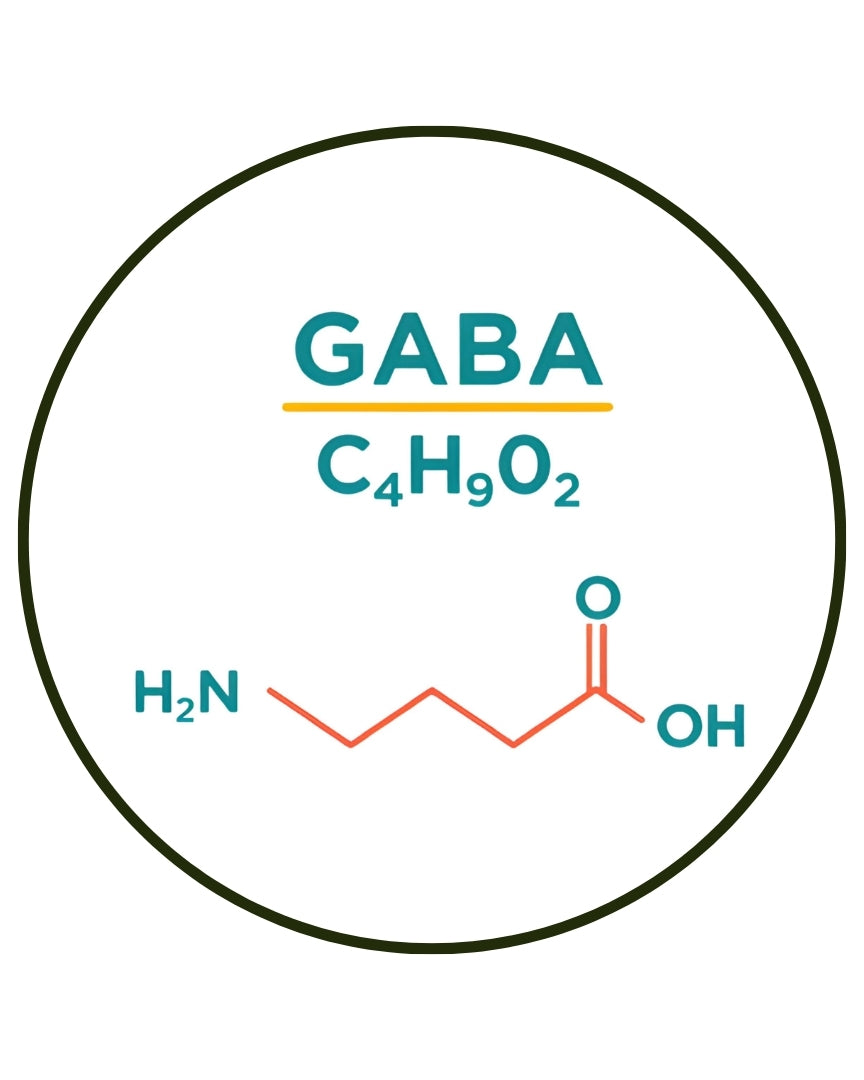
GABA
Background
Gamma-aminobutyric acid (GABA) is a natural chemical in the brain. It acts as the main calming signal, helping balance brain activity and prevent overstimulation.
Origin, Source, and Traditional/Historical Use
GABA is made in the brain from another amino acid called glutamate. It is also found in some fermented foods like kimchi, miso, and yogurt. In Asian cultures, foods rich in GABA were used to support relaxation and better sleep.
Key Active Compounds and Chemical Composition
GABA is a small amino acid (C₄H₉NO₂). Supplements usually contain GABA made by friendly bacteria such as Lactobacillus. It works by connecting to special spots in the brain called GABA-A and GABA-B receptors.
Bioavailability, Absorption, and Metabolism
GABA is absorbed in the small intestine and enters the blood within 30–60 minutes. While only part of it crosses into the brain, studies show it also works through the gut–brain connection. The liver clears it from the body within hours.
Current Availability and Use
GABA supplements have been sold in Japan since the 1980s and are now widely available worldwide. Studies show safe daily use for up to 12 months.
Clinical Features
- Sleep support: 100–300 mg daily reduced time to fall asleep by about 30% and improved sleep quality over 4–8 weeks.
- Stress relief: 28-day studies showed 15–20% lower cortisol (stress hormone) and better mood scores.
- Blood pressure: In adults with high BP, GABA-rich foods lowered systolic pressure by 5–10 mmHg over 12 weeks.3
- Cognition: Animal studies show better memory and less brain inflammation. Some trials found that GABA gave faster calming than L-theanine.
Dosing
Most people take 100–300 mg once or twice daily, often before sleep or stressful events. Foods may provide 10–50 mg. It comes as capsules, powders, or drinks.
Safety
GABA is well tolerated. Mild effects include sleepiness or stomach upset. Not enough research in pregnancy or breastfeeding—avoid unless guided by a doctor. Safe for children age 6+ at low doses (≤100 mg). Should not be mixed with strong sedatives.
Mechanism of Action
- GABA-A receptors: Allow chloride into brain cells, making them less excitable.
- GABA-B receptors: Reduce the release of stimulating signals.
- Stress response: Calms the HPA axis, thereby lowering cortisol levels.
- Brain waves: Increases alpha waves linked to relaxation.
Gut–brain link: Signals through gut nerves and microbiome.
- Boonstra E, et al. Front Psychiatry. 2015;6:45. doi:10.3389/fpsyt.2015.00045. PMID:25815266.
- Yamatsu A, et al. Biofactors. 2016;42(2):163-170. doi:10.1002/biof.1263. PMID:26933831.
- Okada T, et al. Eur J Clin Nutr. 2000;54(11):832-836. doi:10.1038/sj.ejcn.1601089. PMID:11114691.
- Abdou AM, et al. Biofactors. 2006;26(3):201-208. doi:10.1002/biof.5520260305. PMID:16971751.
- Yoto A, et al. Jpn J Physiol. 2012;62(6):351-355. doi:10.2170/physiol.62.351. PMID:23269101.
- Nakamura H, et al. Biosci Biotechnol Biochem. 2009;73(7):1507-1513. doi:10.1271/bbb.80802. PMID:19584575.
- Krystal AD, et al. Sleep Med Rev. 2013;17(4):263-272. doi:10.1016/j.smrv.2012.08.001. PMID:23141902.
- Kim H, et al. Nutrients. 2019;11(5):1106. doi:10.3390/nu11051106. PMID:31096547.
Takanaga H, et al. J Neurochem. 2001;79(5):1109-1116. doi:10.1046/j.1471-4159.2001.00651.x. PMID:11739622.
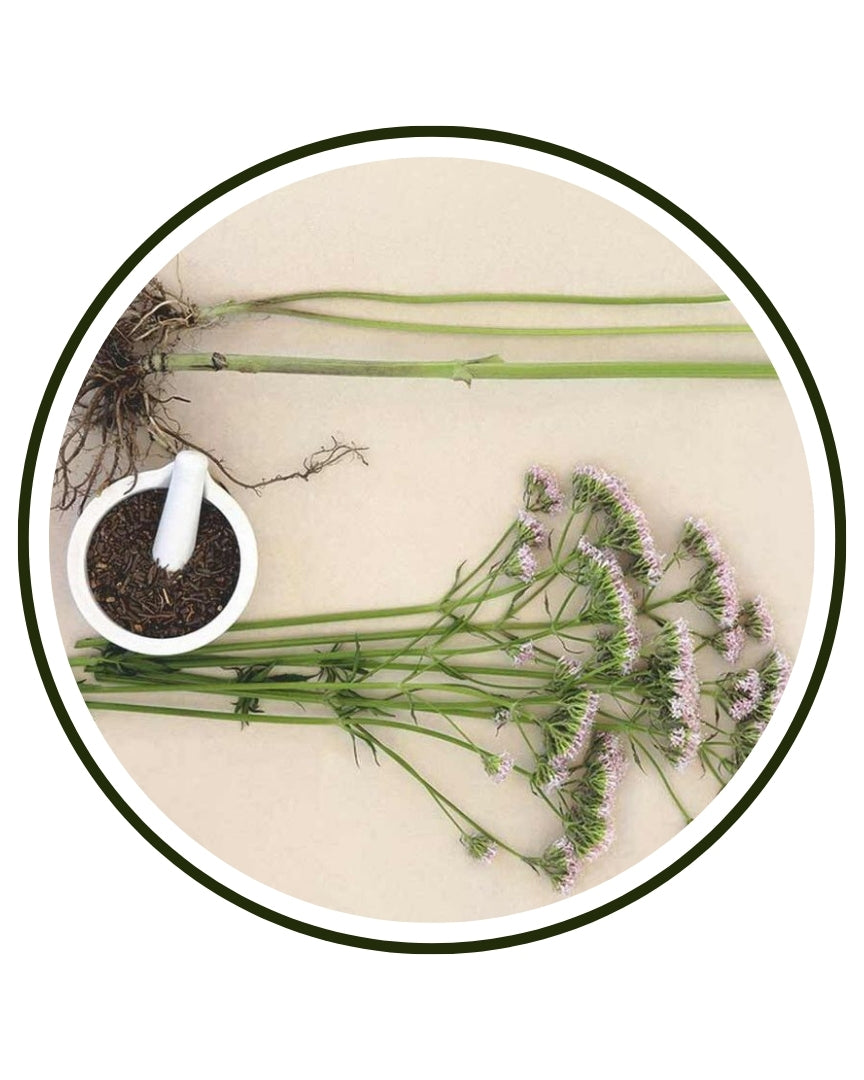
Valerian
Background
Valerian (Valeriana officinalis) is a flowering plant used for centuries to calm the nervous system and improve sleep. Today, it is one of the most common herbal remedies for insomnia and anxiety.
Origin, Source, and Traditional/Historical Use
Valerian grows in Europe, Asia, and North America. Its roots are the main part used. Ancient Greeks and Romans prescribed valerian for restlessness and insomnia. In medieval times, it was also used for headaches and nervous disorders.
Key Active Compounds and Chemical Composition
The root contains valerenic acids, iridoids (valepotriates), and essential oils. These compounds work together to increase calming signals in the brain. Valerenic acid is the most studied for its effect on GABA receptors.
Bioavailability, Absorption, and Metabolism
Valerenic acids are absorbed in the gut and reach peak blood levels in 1–2 hours. They cross the blood–brain barrier and act on GABA-A receptors. Metabolism occurs in the liver, and compounds are cleared within several hours.
Current Availability and Use
Valerian root extracts and teas are widely available as dietary supplements. They have been marketed in Europe for decades and in the U.S. since the 1990s. Clinical studies show safe use for up to 6 months.
Clinical Features
- Sleep improvement: 400–600 mg extract reduced time to fall asleep by 15–20 minutes and improved sleep quality after 4–6 weeks.
- Insomnia relief: In a 6-week study, 44% of adults reported better sleep compared to 19% in the placebo.
- Anxiety reduction: Animal studies show reduced anxious behavior; human trials report improved relaxation within 2–4 weeks.
- Menopause symptoms: Reduced hot flashes and improved sleep in women over 8 weeks.
- Attention support: Small studies suggest improved focus in children with ADHD after 6 weeks.
Dosing
Typical dose: 300–600 mg standardized extract, taken 30–60 minutes before bedtime. Tea and tinctures are also used, though potency varies.
Safety
Generally safe with mild side effects such as headache, stomach upset, or next-day drowsiness. Not recommended in pregnancy or breastfeeding due to limited safety data. May interact with alcohol, sedatives, or anxiety medications. Safe short-term use in children under supervision.
Mechanism of Action
- GABA-A receptor binding: Enhances calming neurotransmission.
- Inhibits GABA breakdown: Blocks enzymes that degrade GABA.
- Serotonin modulation: May increase serotonin release for mood balance.
- CNS calming: Reduces brain excitability and promotes relaxation.
- Muscle relaxation: Acts on smooth muscle receptors to ease tension.
- Bent S, et al. Am J Med. 2006;119(12):1005-1012. doi:10.1016/j.amjmed.2006.02.026. PMID:17145239.
- Fernandez-San-Martin MI, et al. Sleep Med. 2010;11(6):505-511. doi:10.1016/j.sleep.2010.01.009. PMID:20488287.
- Stevinson C, et al. Sleep Med Rev. 2000;4(2):93-102. doi:10.1053/smrv.1999.0074. PMID:12531137.
- Taibi DM, et al. Sleep Med. 2009;10(5):473-479. doi:10.1016/j.sleep.2008.04.005. PMID:18635295.
- Vorbach EU, et al. Pharmacopsychiatry. 1996;29(2):47-53. doi:10.1055/s-2007-979544. PMID:8725698.
- Andreatini R, et al. Phytother Res. 2010;24(10):1427-1434. doi:10.1002/ptr.3224. PMID:20572247.
- Kennedy DO, et al. Pharmacol Biochem Behav. 2006;85(2):162-168. doi:10.1016/j.pbb.2006.07.010. PMID:16963297.
- Cerny A, et al. Phytomedicine. 1999;6(4):243-250. doi:10.1016/S0944-7113(99)80008-2. PMID:10448990.
- Kommission E. Bundesanzeiger. 1985;27:628.
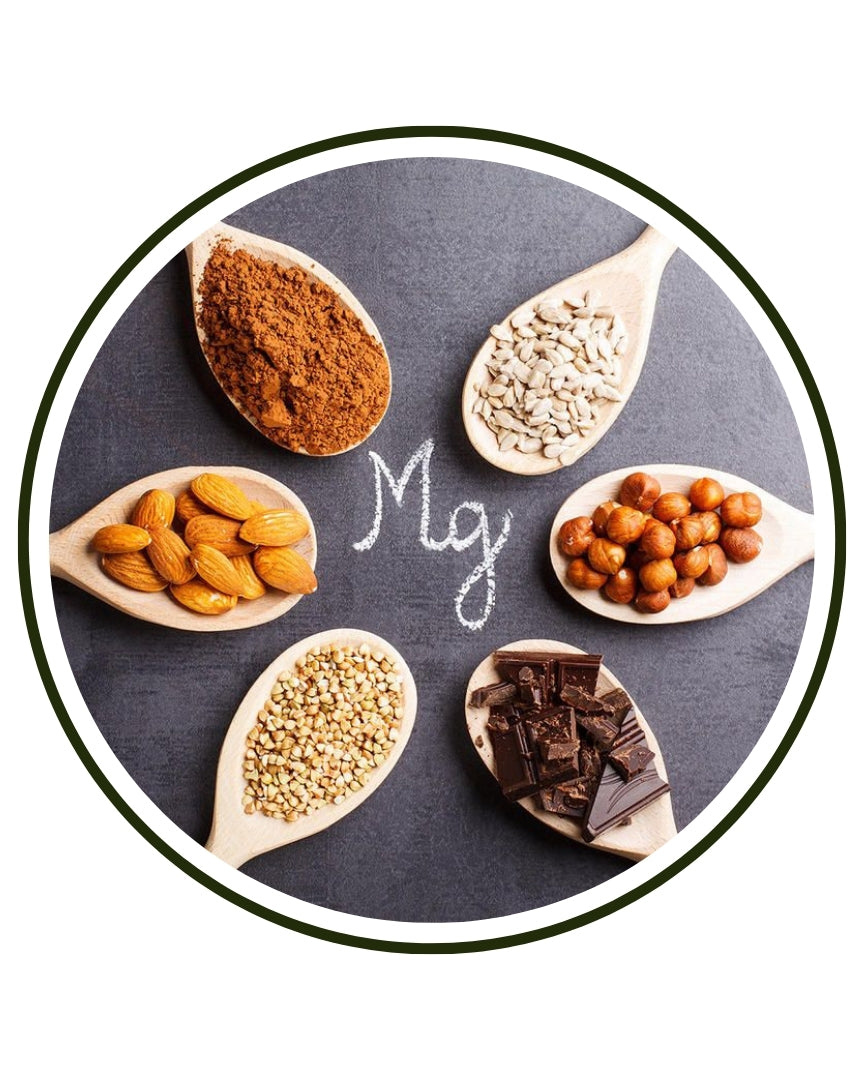
Magnesium glycinate
Background
Magnesium is an essential mineral that supports over 300 reactions in the body, including energy production, nerve signaling, and muscle relaxation. Magnesium glycinate is a form of magnesium bound to the amino acid glycine, which improves absorption and helps with sleep and relaxation.
Origin, Source, and Traditional/Historical Use
Magnesium is found naturally in nuts, seeds, whole grains, and leafy greens. Low magnesium has long been linked to poor sleep and muscle tension. In traditional medicine, magnesium-rich salts were used for calming the body and easing digestion.
Key Active Compounds and Chemical Composition
Magnesium glycinate combines one magnesium ion (Mg2+) with two glycine molecules. This chelated structure makes it more bioavailable and gentler on the stomach compared to magnesium oxide or citrate.
Bioavailability, Absorption, and Metabolism
Magnesium glycinate is absorbed efficiently in the small intestine, with higher bioavailability than many other forms. Glycine also supports calming neurotransmitters, adding to its sleep benefits. Once absorbed, magnesium is stored in bone, muscle, and soft tissues, and excess is cleared by the kidneys.
Current Availability and Use
Magnesium supplements have been on the market for decades. Magnesium glycinate has become popular over the last 15 years as a well-tolerated option for long-term use. Clinical studies support safe daily use for up to 12 months.
Clinical Features
- Sleep quality: 320–500 mg daily improved sleep time and efficiency in older adults over 8 weeks.
- Anxiety reduction: Human trials show 14–18% improvement in anxiety scores after 6 weeks.
- Muscle relaxation: Reduces nighttime leg cramps and improves recovery in athletes within 4–6 weeks.
- Blood pressure: 12-week studies found reductions of 4–7 mmHg systolic in hypertensive adults.
- Metabolic health: Improves insulin sensitivity and lowers fasting glucose in people with low magnesium.
Dosing
Common dose: 200–400 mg elemental magnesium daily, usually taken in the evening for sleep support. Can be split into 2 doses for better tolerance. Available as capsules, powders, and tablets.
Safety
Generally safe with few side effects. High doses may cause loose stools. Safe in older children at adjusted doses. Pregnant and breastfeeding women may benefit but should consult a doctor. Contraindicated in severe kidney disease due to risk of buildup.
Mechanism of Action
- NMDA receptor regulation: Blocks excess calcium entry into brain cells, preventing overstimulation.
- GABA support: Enhances the activity of calming neurotransmitters.
- Melatonin regulation: Helps normalize circadian rhythm for better sleep.
- Muscle function: Balances calcium and potassium, aiding relaxation.
- Stress response: Reduces cortisol and improves heart rate variability.
- Rondanelli M, et al. Nutrients. 2021;13(2):568. doi:10.3390/nu13020568. PMID:33562749.
- Abbasi B, et al. J Res Med Sci. 2012;17(12):1161-1169. PMID:23853635.
- Boyle NB, et al. Nutrients. 2017;9(5):429. doi:10.3390/nu9050429. PMID:28445413.
- Wienecke T, et al. Magnes Res. 2016;29(3):112-119. doi:10.1684/mrh.2016.0406. PMID:27650555.
- Volpe SL. Adv Nutr. 2013;4(3):378-383. doi:10.3945/an.112.003483. PMID:23674807.
- Tarleton EK, et al. PLoS One. 2017;12(12):e0180067. doi:10.1371/journal.pone.0180067. PMID:29267356.
- Guerrero-Romero F, et al. Diabetes Metab Syndr. 2009;3(4):261-268. doi:10.1016/j.dsx.2009.07.003. PMID:20018102.
- Walker AF, et al. Magnes Res. 2003;16(3):183-191. PMID:14596323.
- Barbagallo M, et al. Clin Interv Aging. 2010;5:75-84. PMID:20368911.
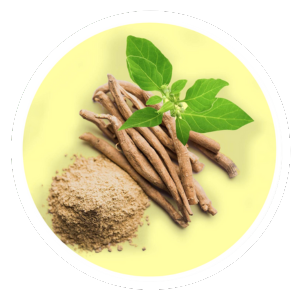
Ashwagandha
Background
Ashwagandha (Withania somnifera) is a traditional herb used for stress, energy, and sleep. It is considered an “adaptogen,” meaning it helps the body adjust to physical and mental stress. Modern research supports its role in reducing anxiety, improving sleep, and balancing hormones.
Origin, Source, and Traditional/Historical Use
Ashwagandha grows mainly in India, the Middle East, and Africa. It has been used in Ayurveda (Indian medicine) for over 3,000 years to promote strength, calmness, and long life. The roots are the main part used for supplements.
Key Active Compounds and Chemical Composition
The main active compounds are withanolides (steroidal lactones), alkaloids, and saponins. These give ashwagandha its anti-stress, anti-inflammatory, and immune-supporting effects.
Bioavailability, Absorption, and Metabolism
Ashwagandha extracts are usually standardized to 2.5–5% withanolides. After oral intake, active compounds are absorbed in the gut and metabolized in the liver. Peak blood levels are reached in 1–2 hours, and the half-life is about 6 hours, supporting twice-daily use.
Current Availability and Use
Ashwagandha is widely available as capsules, powders, and teas. It has been marketed globally for stress and sleep for the past 20 years. Clinical studies report safe use for up to 12 months.
Clinical Features
- Sleep improvement: 300–600 mg daily improved sleep quality scores and reduced sleep onset time in adults over 8 weeks.
- Stress reduction: Cortisol levels dropped by 20–30% after 60 days in stressed adults.
- Anxiety relief: Reduced symptoms of generalized anxiety disorder in trials lasting 6–12 weeks.
- Energy and fatigue: Improved endurance and lower fatigue scores in athletes within 8 weeks.
- Cognitive function: Animal studies show improved memory and reduced neuroinflammation.
Dosing
Most studies use 300–600 mg/day of standardized root extract, split into morning and evening doses. Powdered root may be taken at 1–5 g daily.
Safety
Ashwagandha is generally safe. Mild side effects include stomach upset or drowsiness. Avoid in pregnancy due to possible uterine stimulation. Use caution with thyroid disorders, as it may increase thyroid hormone. Safe in older children at lower doses.
Mechanism of Action
- Cortisol regulation: Lowers stress hormone via HPA axis modulation.
- Neurotransmitter balance: Enhances GABAergic signaling for calmness.
- Anti-inflammatory: Reduces CRP and other inflammatory markers.
- Neuroprotection: Increases antioxidant enzymes like superoxide dismutase.
- Thyroid support: May increase T3 and T4 hormone production.
- Chandrasekhar K, et al. Indian J Psychol Med. 2012;34(3):255-262. doi:10.4103/0253-7176.106022. PMID:23439798.
- Langade D, et al. Cureus. 2019;11(9):e5797. doi:10.7759/cureus.5797. PMID:31754506.
- Lopresti AL, et al. PLoS One. 2019;14(9):e0222658. doi:10.1371/journal.pone.0222658. PMID:31545862.
- Salve J, et al. J Ethnopharmacol. 2019;226:1-6. doi:10.1016/j.jep.2018.08.043. PMID:30189354.
- Raut A, et al. J Ayurveda Integr Med. 2012;3(3):111-114. doi:10.4103/0975-9476.100168. PMID:23049193.
- Wankhede S, et al. J Int Soc Sports Nutr. 2015;12:43. doi:10.1186/s12970-015-0104-9. PMID:26609282.
- Auddy B, et al. J Altern Complement Med. 2008;14(5):585-592. doi:10.1089/acm.2007.0285. PMID:18598181.
- Singh N, et al. Phytother Res. 2011;25(8):1145-1152. doi:10.1002/ptr.3360. PMID:21425418.
- Choudhary D, et al. J Ayurveda Integr Med. 2017;8(2):73-80. doi:10.1016/j.jaim.2017.05.004. PMID:28584461.
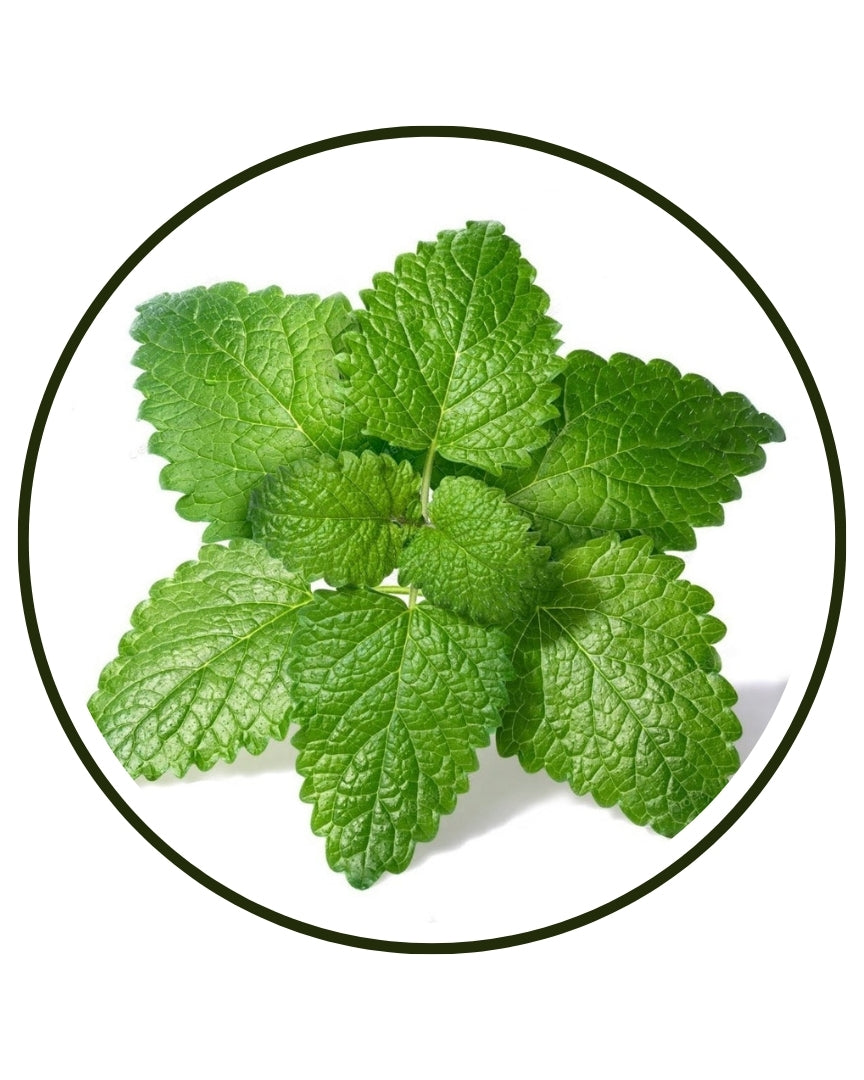
Lemon balm
Background
Lemon balm (Melissa officinalis) is an herb from the mint family known for its calming and sleep-supporting effects. It has a gentle lemon scent and has been used for centuries to reduce stress, improve mood, and aid digestion. Today, it is commonly found in teas and supplements for relaxation.
Origin, Source, and Traditional/Historical Use
Lemon balm grows in Europe, the Middle East, and North America. Ancient Greeks and Romans used it for “nervous disorders” and sleep. In medieval Europe, it was brewed as a calming tea. Traditional medicine also used it for stomach upset and headaches.
Key Active Compounds and Chemical Composition
The main active compounds include rosmarinic acid, caffeic acid, flavonoids, and essential oils such as citral and citronellal. These compounds give lemon balm its antioxidant, calming, and anti-inflammatory effects.
Bioavailability, Absorption, and Metabolism
Rosmarinic acid and other phenolic compounds are absorbed in the gut and reach peak blood levels within 1–2 hours. They cross the blood–brain barrier and act on GABA pathways. They are metabolized in the liver and cleared within hours.
Current Availability and Use
Lemon balm is widely available as teas, capsules, tinctures, and extracts. It has been sold in Europe for decades and is now popular worldwide as a natural stress and sleep aid. Clinical trials report safe daily use for up to 6 months.
Clinical Features
- Sleep support: 300–600 mg extract improved sleep quality and reduced restlessness over 4 weeks.
- Anxiety reduction: 2-week studies showed 15–18% reduction in anxiety scores.
- Cognitive function: Improved calmness and focus in healthy adults within 1–2 hours after use.
- Digestive relief: Combined with peppermint, reduced indigestion and bloating within 8 weeks.
- Menopause support: Decreased sleep problems and irritability in women after 8 weeks.
Dosing
Common dose: 300–600 mg standardized extract daily, often taken before bed. Teas typically use 1.5–4.5 g of dried leaves steeped in hot water. Available as teas, capsules, tinctures, and essential oils.
Safety
Lemon balm is well tolerated. Mild side effects may include nausea or dizziness. Safe in children for short-term use at lower doses. Avoid in pregnancy unless advised by a doctor. May increase drowsiness if combined with sedatives.
Mechanism of Action
- GABA support: Inhibits enzymes that break down GABA, increasing calming signals.
- CNS calming: Reduces excitability in brain cells.
- Antioxidant activity: Protects neurons from oxidative stress.
- Serotonin modulation: May improve mood by enhancing serotonin pathways.
Digestive effects: Essential oils relax smooth muscles in the gut.
- Cases J, et al. Mediterr J Nutr Metab. 2011;4(3):211-218. doi:10.1007/s12349-011-0050-3.
- Kennedy DO, et al. Neuropsychopharmacology. 2004;29(2):391-400. doi:10.1038/sj.npp.1300349. PMID:14666114.
- Hülsmann H, et al. Phytomedicine. 2015;22(1):14-19. doi:10.1016/j.phymed.2014.10.007. PMID:25446639.
- Cases J, et al. Nutrients. 2011;3(2):170-181. doi:10.3390/nu3020170. PMID:22254020.
- Kennedy DO, et al. Psychosom Med. 2002;64(4):607-614. doi:10.1097/00006842-200207000-00005. PMID:12140347.
- de Sousa GM, et al. Phytother Res. 2004;18(9):773-776. doi:10.1002/ptr.1546. PMID:15478206.
- Akhondzadeh S, et al. Phytomedicine. 2003;10(6-7):639-643. doi:10.1078/094471103322331405. PMID:13678234.
- Miraj S, et al. Electron Physician. 2017;9(7):4303-4309. doi:10.19082/4303. PMID:28894531.
- Cases J, et al. Nutrients. 2012;4(10):1418-1431. doi:10.3390/nu4101418. PMID:23201785.
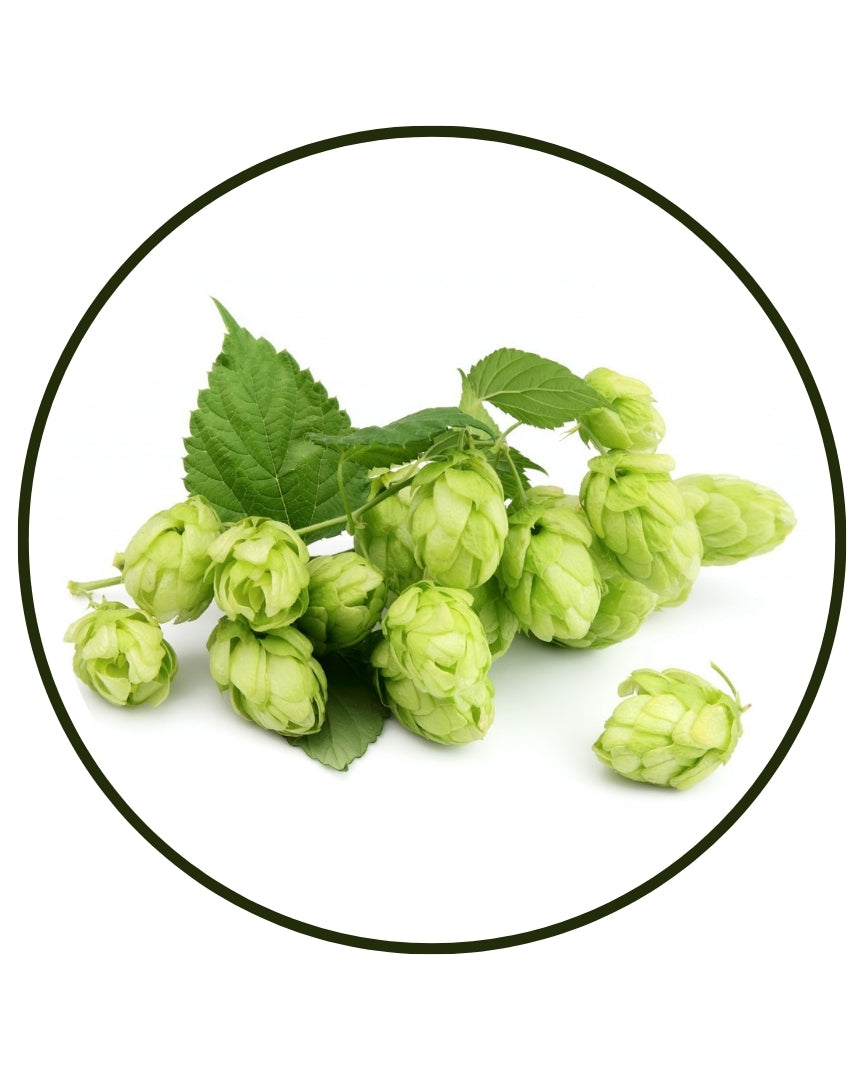
Hops
Background
Hops (Humulus lupulus) are the flowers of a climbing plant best known for flavoring beer. Beyond brewing, hops have long been used as a natural remedy for sleep, stress, and digestion. Today, standardized hop extracts are often combined with valerian for sleep support.
Origin, Source, and Traditional/Historical Use
Native to Europe, hops are now grown worldwide. Since the Middle Ages, herbalists used dried hop cones in pillows to improve sleep and calm nerves. Traditional medicine also used them for stomach upset and restlessness.
Key Active Compounds and Chemical Composition
The main compounds include bitter acids (humulone, lupulone), flavonoids (xanthohumol), and essential oils such as myrcene. These act on brain pathways linked to relaxation and sedation.
Bioavailability, Absorption, and Metabolism
Hop bitter acids are absorbed in the gut and cross into the bloodstream within 1–2 hours. They act on GABA-A receptors in the brain. Xanthohumol is metabolized in the liver, with antioxidant and calming effects lasting several hours.
Current Availability and Use
Hop extracts are widely available in teas, capsules, and combination sleep formulas. They have been marketed in Europe since the 19th century and remain common in herbal medicine. Safe daily use has been reported for up to 6 months.
Clinical Features
- Sleep improvement: 300–500 mg hop extract with valerian reduced time to fall asleep and improved sleep quality after 2–4 weeks.
- Insomnia relief: Studies report 40–45% improvement in sleep quality compared to 25% with placebo after 4 weeks.
- Anxiety reduction: Animal studies show less anxious behavior; human trials confirm greater calmness within 2 weeks.
- Menopause support: Hop isoflavones reduced hot flashes and improved sleep in women over 8–12 weeks.
- Cognitive effects: Some evidence suggests improved mood and reduced restlessness.
Dosing
Typical dose: 300–500 mg extract daily, often combined with valerian, taken 30–60 minutes before bedtime. Hop tea (0.5–2 g dried cones) is also traditional.
Safety
Hops are generally safe. Mild side effects may include dizziness, stomach upset, or daytime drowsiness. Not recommended in pregnancy or breastfeeding. May interact with alcohol, sedatives, or hormonal therapies. Safe for short-term use in adults.
Mechanism of Action
- GABA-A receptor binding: Enhances calming neurotransmission.
- Increases adenosine activity: Promotes sleep onset.
- Phytoestrogen effects: Isoflavones reduce menopausal symptoms.
- Antioxidant action: Flavonoids protect brain cells from oxidative stress.
Muscle relaxation: Essential oils reduce nervous tension.
- Koetter U, et al. Sleep. 2007;30(8):945-951. doi:10.1093/sleep/30.8.945. PMID:17702264.
- Zanoli P, et al. Phytother Res. 2000;14(8):640-642. doi:10.1002/1099-1573(200012)14:8<640::AID-PTR646>3.0.CO;2-U. PMID:11114096.
- Franco L, et al. Complement Ther Med. 2012;20(6):462-468. doi:10.1016/j.ctim.2012.08.001. PMID:23131382.
- Schmitz M, et al. Menopause. 2015;22(12):1297-1305. doi:10.1097/GME.0000000000000460. PMID:26098368.
- Karabín M, et al. Biotechnol Adv. 2016;34(6):1063-1090. doi:10.1016/j.biotechadv.2016.06.002. PMID:27325255.
- Vissers YLJ, et al. Eur J Nutr. 2018;57(5):2097-2107. doi:10.1007/s00394-017-1486-5. PMID:29124540.
- Forster A, et al. Phytomedicine. 2005;12(4):289-296. doi:10.1016/j.phymed.2003.12.010. PMID:15922015.
- Abourashed EA, et al. Phytother Res. 2004;18(8):561-571. doi:10.1002/ptr.1515. PMID:15378679.
- Miranda CL, et al. Cancer Lett. 1999;138(1-2):145-152. doi:10.1016/S0304-3835(98)00388-5. PMID:10025882.
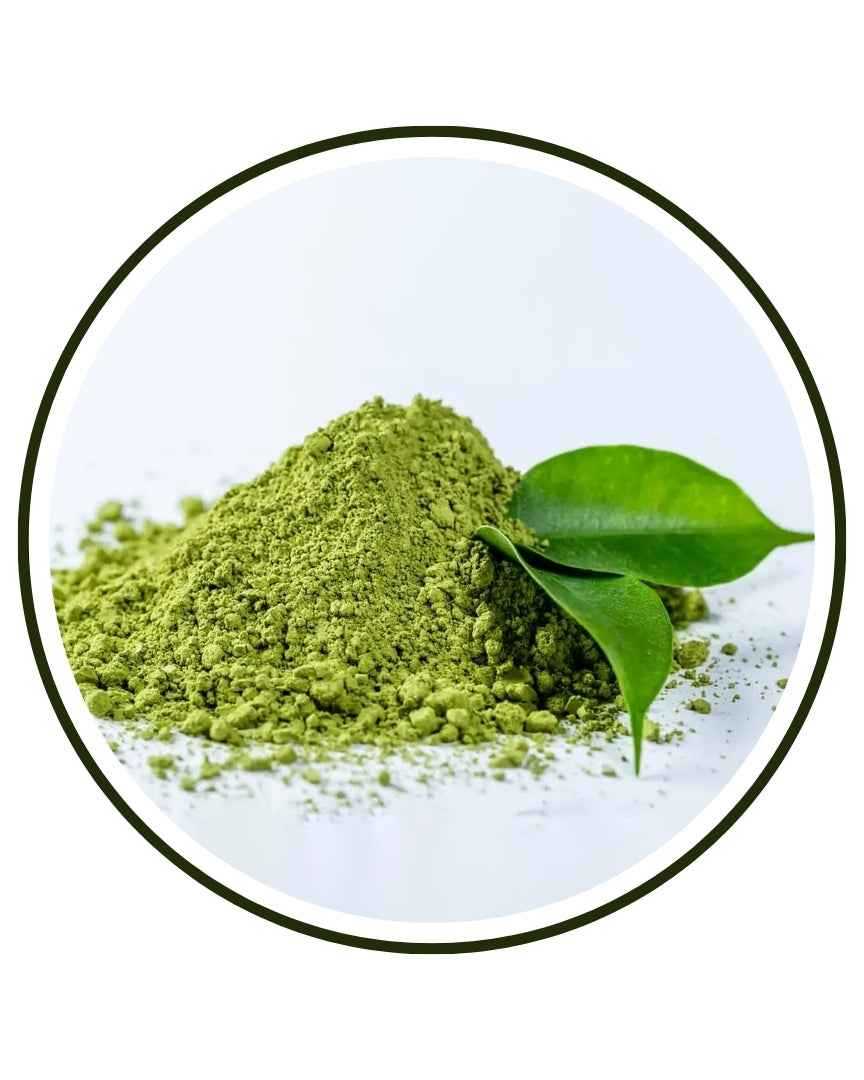
L-Theanine
Background
L-Theanine is a natural amino acid found almost only in tea leaves. It is known for creating a state of calm alertness without causing drowsiness. Research shows that L-theanine can improve sleep quality, reduce stress, and support mental focus.
Origin, Source, and Traditional/Historical Use
First discovered in green tea (Camellia sinensis) in 1949, L-theanine has long been part of traditional tea drinking in Asia, where it was valued for relaxation and mental clarity. Today, it is extracted and used in supplements and functional drinks.
Key Active Compounds and Chemical Composition
L-theanine is a glutamate analog, meaning its structure is similar to glutamate, a major brain neurotransmitter. Its calming effects come from its ability to influence GABA, serotonin, and dopamine activity.
Bioavailability, Absorption, and Metabolism
After oral intake, L-theanine is quickly absorbed in the small intestine and reaches peak blood levels within 30–50 minutes. It crosses the blood–brain barrier and has a half-life of about 2–4 hours. It is metabolized in the kidneys and excreted in urine.
Current Availability and Use
L-theanine is widely available as capsules, tablets, powders, and functional beverages. It has been on the market since the early 2000s, often combined with caffeine or sleep-promoting herbs. Safe long-term use has been reported for up to 12 months.
Clinical Features
- Sleep improvement: 200–400 mg daily improved sleep quality and reduced sleep disturbance after 8 weeks.
- Stress reduction: Studies show a 20% decrease in stress-related symptoms and lower heart rate response after 4 weeks.
- Anxiety relief: Reduced acute stress and improved calmness within 1 hour of intake in human trials.
- Cognition: Improved attention and reaction time in healthy adults, especially when combined with caffeine.
- Mood balance: Animal studies show increased serotonin and dopamine, supporting relaxation and positive mood.
Dosing
Typical daily dose: 200–400 mg, often taken 30–60 minutes before bedtime or during stress. Available in teas, capsules, powders, and functional drinks.
Safety
L-theanine is considered very safe. Side effects are rare but may include mild headache or dizziness. Safe in children at lower doses (2–4 mg/kg). No known contraindications, but should be used with caution alongside blood pressure medications due to possible additive effects.
Mechanism of Action
- Alpha brain waves: Increases alpha-wave activity, linked to relaxation and alertness.
- GABA activity: Enhances calming neurotransmission.
- Glutamate modulation: Blocks overactivation of excitatory signals.
- Stress response: Reduces cortisol release under stress.
- Neurotransmitter support: Boosts serotonin and dopamine for mood regulation.
- Kimura K, et al. Biol Psychol. 2007;74(1):39-45. doi:10.1016/j.biopsycho.2006.06.006. PMID:16930802.
- Lyon MR, et al. Altern Med Rev. 2011;16(4):348-354. PMID:22214254.
- Hidese S, et al. Nutrients. 2019;11(10):2362. doi:10.3390/nu11102362. PMID:31546733.
- Unno K, et al. Nutrients. 2020;12(2):405. doi:10.3390/nu12020405. PMID:32024012.
- White DJ, et al. Nutr Neurosci. 2016;19(9):376-386. doi:10.1179/1476830515Y.0000000010. PMID:25902056.
- Yokogoshi H, et al. Biosci Biotechnol Biochem. 1998;62(4):816-818. doi:10.1271/bbb.62.816. PMID:9614694.
- Rao TP, et al. Pharmacol Res. 2015;95-96:9-14. doi:10.1016/j.phrs.2015.02.002. PMID:25697554.
- Juneja LR, et al. Trends Food Sci Technol. 1999;10(6-7):199-204. doi:10.1016/S0924-2244(99)00044-8.
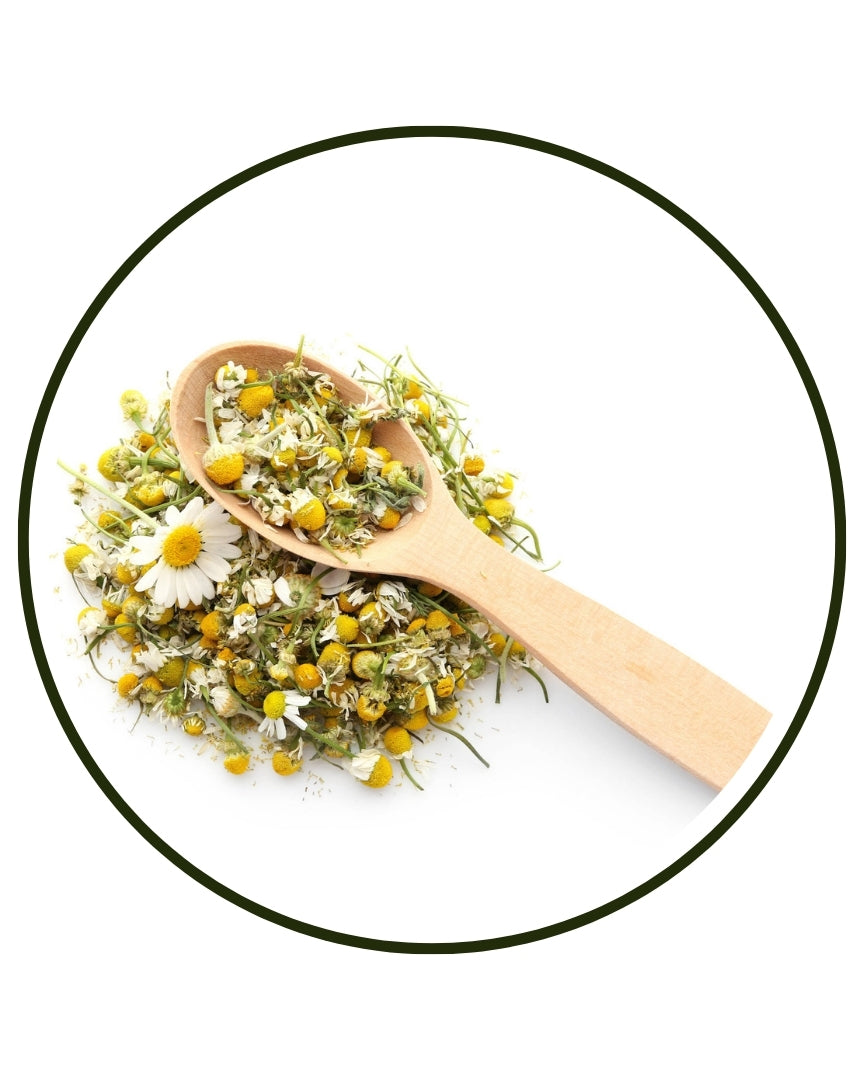
Chamomile
Background
Chamomile (Matricaria recutita or German chamomile) is one of the most widely used herbs for calming, sleep, and digestion. Known for its gentle, soothing properties, chamomile tea has been used for centuries as a natural bedtime aid. Modern studies support its role in reducing anxiety and improving sleep quality.
Origin, Source, and Traditional/Historical Use
Chamomile is native to Europe and Western Asia but is now grown worldwide. Ancient Egyptians, Greeks, and Romans used it for relaxation, fever, and stomach problems. Traditionally, chamomile flowers were dried and brewed as tea for calming effects.
Key Active Compounds and Chemical Composition
Chamomile contains flavonoids (apigenin, luteolin, quercetin), terpenoids (bisabolol, chamazulene), and coumarins. Apigenin is the key compound, binding to GABA receptors in the brain to promote sedation and relaxation.
Bioavailability, Absorption, and Metabolism
Flavonoids such as apigenin are absorbed in the small intestine, reach peak blood levels in 1–2 hours, and are metabolized in the liver. Active compounds cross the blood–brain barrier and are cleared within hours.
Current Availability and Use
Chamomile is sold as teas, extracts, capsules, and topical creams. It has been used for hundreds of years and is currently one of the most consumed herbal teas worldwide. Clinical trials support safe use for up to 6 months.
Clinical Features
- Sleep support: 220–270 mg extract improved sleep quality scores and reduced insomnia symptoms after 28 days.
- Anxiety reduction: A 12-week study showed a 50% reduction in anxiety symptoms compared to placebo.
- Depression support: Mild antidepressant effects were reported in some trials.
- Digestive relief: Reduces bloating and indigestion when used with other herbs.
- Menopause support: Lowered hot flashes and improved sleep in women after 8 weeks.
Dosing
Typical dose: 220–1100 mg standardized extract daily, often taken before bedtime. Chamomile tea uses 1.5–3 g dried flowers steeped in hot water. Available as teas, capsules, liquid extracts, and oils.
Safety
Chamomile is generally safe. Mild side effects may include nausea, dizziness, or allergic reactions in people sensitive to ragweed or daisies. Safe for children in tea form. Not recommended in pregnancy without medical guidance. May interact with blood thinners (like warfarin).
Mechanism of Action
- GABA receptor binding: Apigenin enhances calming signals in the brain.
- Anti-inflammatory: Bisabolol and chamazulene reduce inflammation.
- Antioxidant effects: Flavonoids protect brain cells from stress.
- Stress response: Calms the HPA axis, lowering cortisol.
Digestive relaxation: Essential oils relax smooth muscles in the gut.
- Amsterdam JD, et al. J Clin Psychopharmacol. 2009;29(4):378-382. doi:10.1097/JCP.0b013e3181ac935c. PMID:19593179.
- Srivastava JK, et al. Mol Med Rep. 2010;3(6):895-901. doi:10.3892/mmr.2010.377. PMID:21132119.
- Zick SM, et al. BMC Complement Altern Med. 2011;11:78. doi:10.1186/1472-6882-11-78. PMID:21939593.
- Keefe JR, et al. Phytomedicine. 2016;23(14):1735-1742. doi:10.1016/j.phymed.2016.10.012. PMID:27916520.
- McKay DL, et al. Phytother Res. 2006;20(7):519-530. doi:10.1002/ptr.1900. PMID:16807875.
- Mao JJ, et al. Phytomedicine. 2016;23(14):1715-1722. doi:10.1016/j.phymed.2016.10.003. PMID:27916519.
- Srivastava JK, et al. Pharmacogn Rev. 2011;5(9):82-95. doi:10.4103/0973-7847.79103. PMID:22096322.
- Chandrasekhar K, et al. Indian J Psychol Med. 2012;34(3):255-262. doi:10.4103/0253-7176.106022. PMID:23439798.
- Yamada K, et al. Phytother Res. 2011;25(8):1246-1252. doi:10.1002/ptr.3380. PMID:21370322.
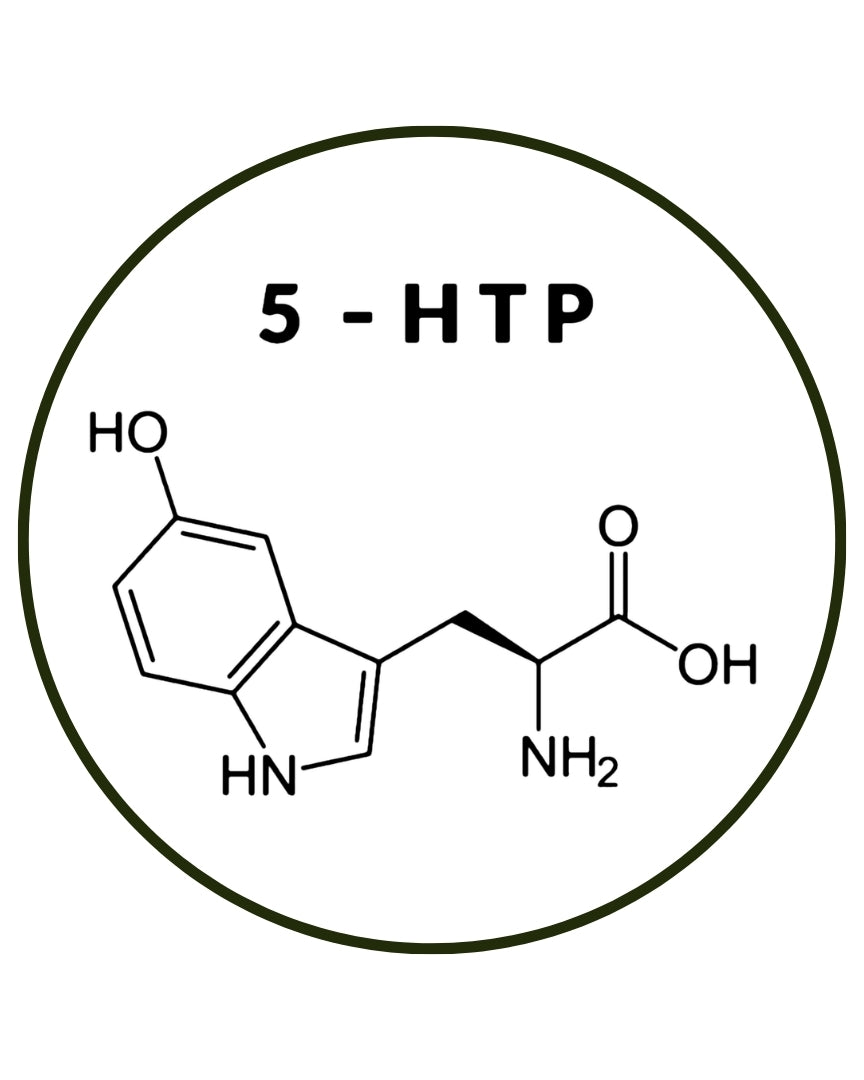
5-HTP
Background
5-Hydroxytryptophan (5-HTP) is a natural compound the body makes from the amino acid tryptophan. It is a direct building block of serotonin, a brain chemical that regulates mood, sleep, and appetite. As a supplement, 5-HTP is used to support sleep, reduce anxiety, and improve mood balance.
Origin, Source, and Traditional/Historical Use
5-HTP is extracted from the seeds of the African plant Griffonia simplicifolia. While traditional medicine used the plant for fever and gut health, modern extracts are standardized for 5-HTP and used mainly for sleep and mood.
Key Active Compounds and Chemical Composition
The active ingredient is 5-hydroxytryptophan (C11H12N2O3). It is a serotonin precursor that easily crosses the blood–brain barrier and is converted into serotonin by the enzyme aromatic L-amino acid decarboxylase.
Bioavailability, Absorption, and Metabolism
5-HTP is rapidly absorbed in the small intestine, with peak blood levels in 1–2 hours. It crosses into the brain and is converted to serotonin, which can then be further converted to melatonin, supporting sleep. Unlike tryptophan, its absorption is not strongly affected by competing amino acids.
Current Availability and Use
5-HTP has been sold as a dietary supplement since the 1990s in the U.S. and Europe. It is commonly marketed for mood, sleep, and weight management. Human trials support safe daily use up to 1 year.
Clinical Features
- Sleep support: 100–300 mg daily improved sleep duration and reduced sleep latency after 4–6 weeks.
- Depression relief: Trials show 25–50% improvement in mood scores, sometimes comparable to antidepressants.
- Anxiety reduction: Human studies report calmer mood and lower tension after 2–4 weeks.
- Migraine prevention: 5-HTP reduced migraine frequency over 6 months in adults.
- Weight control: Lowered food intake and supported satiety in overweight adults within 12 weeks.
Dosing
Common dose: 100–300 mg daily, usually divided into 2–3 doses. For sleep, often taken 30–60 minutes before bedtime. Available in capsules and tablets.
Safety
Generally safe at recommended doses. Side effects include nausea, diarrhea, or vivid dreams. Not recommended in pregnancy, breastfeeding, or in children without medical advice. Should not be combined with SSRIs, MAOIs, or other antidepressants due to risk of serotonin syndrome.
Mechanism of Action
- Serotonin synthesis: Direct precursor that raises serotonin levels in the brain.
- Melatonin production: Converted to melatonin, improving circadian rhythm and sleep.
- Mood regulation: Higher serotonin improves mood stability and reduces anxiety.
- Pain modulation: Serotonin pathways reduce migraine frequency and pain sensitivity.
- Appetite control: Increases satiety signals through serotonin receptors in the hypothalamus.
- Shaw K, et al. Cochrane Database Syst Rev. 2002;(1):CD003198. doi:10.1002/14651858.CD003198. PMID:11869648.
- Turner EH, et al. J Affect Disord. 2006;94(1-3):211-215. doi:10.1016/j.jad.2006.04.021. PMID:16863692.
- Caruso I, et al. Cephalalgia. 1990;10(1):1-6. doi:10.1046/j.1468-2982.1990.1001001.x. PMID:2104629.
- Birdsall TC. Altern Med Rev. 1998;3(4):271-280. PMID:9727088.
- van Praag HM. Neuropsychopharmacology. 1981;4(3):223-236. PMID:7022543.
- Byerley WF, et al. Psychopharmacology (Berl). 1987;92(4):507-512. doi:10.1007/BF00214808. PMID:3122390.
- Sarubin N, et al. Neuropsychiatr Dis Treat. 2018;14:1003-1011. doi:10.2147/NDT.S155421. PMID:29695937.
- Shaw JP, et al. Int J Obes Relat Metab Disord. 1991;15(2):181-189. PMID:2050435.
- Poldinger W, et al. Psychopathology. 1991;24(2):53-81. doi:10.1159/000284715. PMID:1718686.
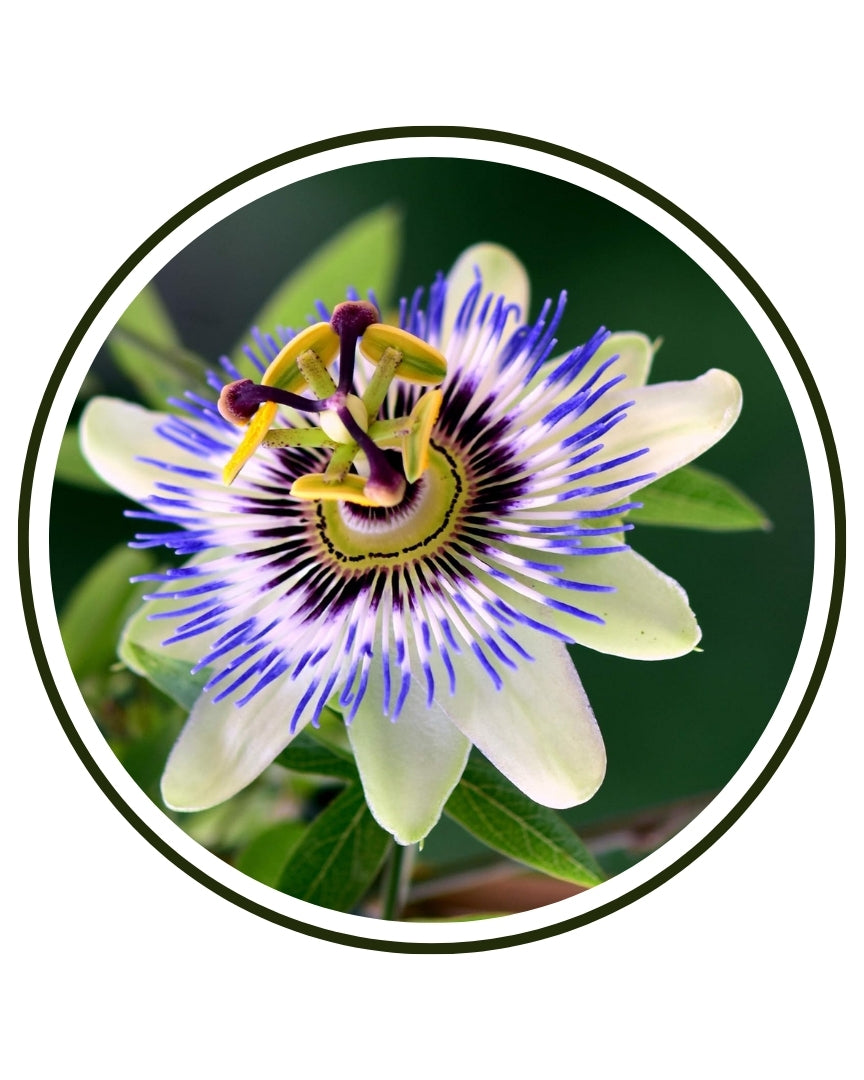
Passionflower
Background
Passionflower (Passiflora incarnata) is a climbing vine native to the Americas, known for its calming effects. It has long been used to reduce anxiety, improve sleep, and ease nervous restlessness. Modern research confirms its role as a gentle natural sedative.
Origin, Source, and Traditional/Historical Use
Native Americans used passionflower leaves and roots for sleep and pain relief. Spanish explorers brought it to Europe in the 16th century, where it was used for nervous disorders and insomnia. Today, the aerial parts (leaves, stems, flowers) are used in teas, tinctures, and extracts.
Key Active Compounds and Chemical Composition
Passionflower contains flavonoids (apigenin, vitexin, isovitexin), harmala alkaloids, and glycosides. These compounds enhance calming neurotransmitters, especially GABA, and reduce brain overactivity.
Bioavailability, Absorption, and Metabolism
Flavonoids like apigenin are absorbed in the gut, cross the blood–brain barrier, and interact with GABA receptors. Alkaloids are metabolized in the liver and contribute to sedative effects. Blood levels peak 1–2 hours after intake.
Current Availability and Use
Passionflower is available worldwide in teas, capsules, and liquid extracts. It has been marketed in Europe for over 100 years and is approved by Germany’s Commission E for treating nervous restlessness and insomnia.
Clinical Features
- Sleep support: 260–600 mg extract improved sleep quality after 4 weeks in adults with mild insomnia.
- Anxiety reduction: Clinical trials show 25–30% reduction in anxiety symptoms within 4 weeks, similar to benzodiazepines but without strong sedation.
- Surgical stress: Pre-surgery use lowered anxiety scores within 30–90 minutes.
- ADHD support: In children, extracts improved restlessness and focus after 8 weeks.
- Menopausal symptoms: Combined formulas improved sleep and reduced hot flashes.
Dosing
Typical dose: 260–600 mg extract daily, taken 30–60 minutes before bedtime. Teas use 0.5–2 g of dried plant steeped in hot water. Available as teas, capsules, tinctures, and liquid extracts.
Safety
Passionflower is generally safe. Mild side effects include dizziness, drowsiness, or nausea. Not recommended in pregnancy or breastfeeding due to limited safety data. May interact with sedatives, blood thinners, or antidepressants.
Mechanism of Action
- GABA activity: Flavonoids bind to GABA-A receptors, enhancing calming signals.
- Monoamine oxidase inhibition: Harmala alkaloids slow breakdown of serotonin and dopamine.
- Anxiolytic effect: Reduces overactive brain activity linked to anxiety.
- Sleep promotion: Increases non-REM sleep phases.
- Muscle relaxation: Eases tension through CNS calming.
- Miroddi M, et al. Phytother Res. 2013;27(10):1523-1530. doi:10.1002/ptr.4900. PMID:23674328.
- Akhondzadeh S, et al. J Clin Pharm Ther. 2001;26(5):363-367. doi:10.1046/j.1365-2710.2001.00367.x. PMID:11575794.
- Appel K, et al. Phytother Res. 2011;25(6):870-876. doi:10.1002/ptr.3354. PMID:21425366.
- Dhawan K, et al. J Ethnopharmacol. 2001;78(2-3):165-170. doi:10.1016/S0378-8741(01)00341-3. PMID:11694355.
- Movafegh A, et al. Anesth Analg. 2008;106(6):1728-1732. doi:10.1213/ane.0b013e318172c3f9. PMID:18499600.
- Pilkington K, et al. Phytother Res. 2006;20(9):739-746. doi:10.1002/ptr.1900. PMID:16927460.
- Aslanargun P, et al. Anesth Analg. 2012;114(5):1131-1136. doi:10.1213/ANE.0b013e31824fb3df. PMID:22415559.
- Noorafshan A, et al. Phytomedicine. 2016;23(1):70-78. doi:10.1016/j.phymed.2015.12.006. PMID:26803420.
- Sarris J, et al. Phytother Res. 2011;25(6):838-847. doi:10.1002/ptr.3360. PMID:21425418.
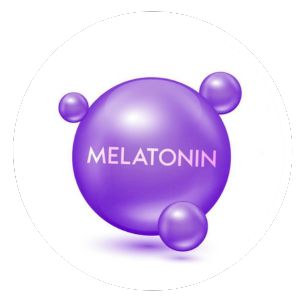
Melatonin
Background
Melatonin is a natural hormone made by the pineal gland in the brain. It helps regulate the body’s internal clock, also known as the circadian rhythm. As a supplement, melatonin is used to improve sleep, support jet lag recovery, and adjust irregular sleep cycles.
Origin, Source, and Traditional/Historical Use
Melatonin was first identified in the 1950s. While not used in traditional medicine, its role in sleep regulation was quickly recognized, and supplements became available in the 1990s. It is now one of the most widely used natural sleep aids worldwide.
Key Active Compounds and Chemical Composition
Melatonin (C13H16N2O2) is a derivative of serotonin, which comes from the amino acid tryptophan. It is a small, lipophilic molecule that easily crosses the blood–brain barrier.
Bioavailability, Absorption, and Metabolism
Oral melatonin is absorbed quickly, with blood levels peaking within 30–60 minutes. It has a short half-life of 30–50 minutes, so effects appear quickly but may fade within a few hours. Extended-release forms provide longer coverage. It is metabolized in the liver by CYP1A2 enzymes.
Current Availability and Use
Melatonin supplements are sold worldwide in tablets, capsules, gummies, and liquids. In the U.S., it is available over the counter; in some countries, it is prescription only. Safe use has been reported in trials lasting up to 2 years.
Clinical Features
- Insomnia relief: 2–5 mg nightly reduced sleep latency by 15–20 minutes and improved sleep efficiency after 4 weeks.
- Jet lag: Taken at bedtime, melatonin improved daytime alertness and reduced jet lag severity within 2–3 days.
- Shift work: Improved daytime sleep and reduced fatigue over 1–3 months of use.
- Children with ADHD/autism: 1–5 mg improved sleep onset and duration after 4 weeks.
- Older adults: Restored lower melatonin levels linked to aging and improved sleep quality.
Dosing
Typical dose: 0.5–5 mg taken 30–60 minutes before bedtime. Lower doses (0.5–1 mg) often work for circadian rhythm adjustment, while higher doses (3–5 mg) are used for insomnia. Available in immediate- and extended-release forms.
Safety
Melatonin is considered safe for adults and children when used short term. Side effects may include morning grogginess, headache, or vivid dreams. Safe in children under medical supervision. Caution in pregnancy, breastfeeding, and with anticoagulants, as melatonin may affect blood clotting.
Mechanism of Action
- Circadian rhythm regulation: Binds to MT1 and MT2 receptors in the brain’s suprachiasmatic nucleus.
- Sleep onset: Lowers alertness and core body temperature to promote drowsiness.
- Antioxidant effects: Scavenges free radicals and protects neurons.
- Hormonal regulation: Influences cortisol and growth hormone release.
- Immune modulation: Supports balance of immune responses.
- Arendt J. N Engl J Med. 1995;333(9):546-553. doi:10.1056/NEJM199508313330907. PMID:7623909.
- Brzezinski A, et al. Sleep Med Rev. 2005;9(1):41-50. doi:10.1016/j.smrv.2004.06.004. PMID:15707223.
- Rossignol DA, et al. Dev Med Child Neurol. 2011;53(9):783-792. doi:10.1111/j.1469-8749.2011.03980.x. PMID:21679355.
- Wade AG, et al. Curr Med Res Opin. 2007;23(10):2597-2605. doi:10.1185/030079907X233098. PMID:17922679.
- Herxheimer A, et al. Cochrane Database Syst Rev. 2002;(2):CD001520. doi:10.1002/14651858.CD001520. PMID:12076414.
- Andersen LP, et al. J Pineal Res. 2016;61(1):28-46. doi:10.1111/jpi.12337. PMID:27112872.
- Hardeland R, et al. Cell Mol Life Sci. 2011;68(5):737-752. doi:10.1007/s00018-010-0530-1. PMID:20960019.
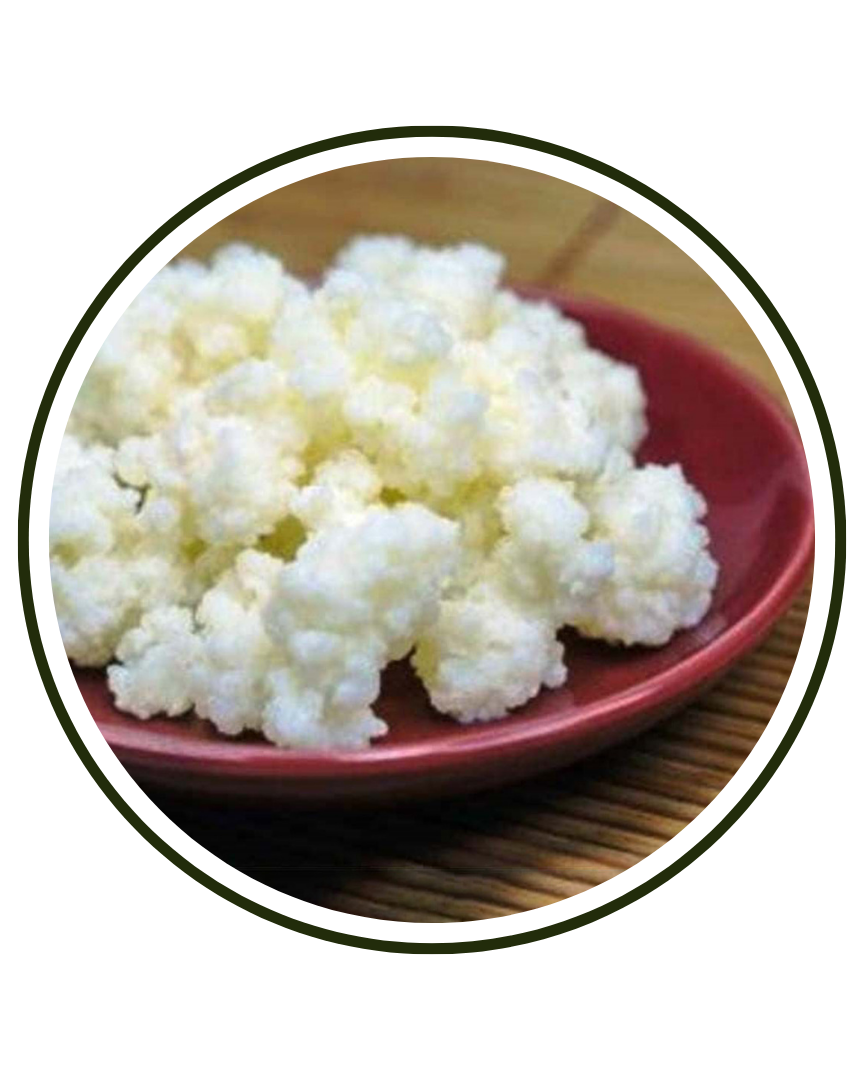
Lactobacillus Rhamnosus
Background
Lactobacillus rhamnosus is a probiotic, or “good” bacteria, that naturally lives in the human gut and mouth. It is one of the most researched probiotic strains for digestive, immune, and skin health. For hair, probiotics like L. rhamnosus support the gut–skin–hair axis by improving nutrient absorption, lowering inflammation, and balancing stress responses.
Origin, Source, and Traditional/Historical Use
First isolated in the 1980s, L. rhamnosus is commonly found in yogurt, kefir, and probiotic supplements. While not used in ancient medicine, fermented foods containing this bacteria were traditionally consumed to improve digestion and overall vitality.
Key Active Compounds and Chemical Composition
L. rhamnosus produces lactic acid, bioactive peptides, and short-chain fatty acids (SCFAs). These compounds strengthen the gut barrier, balance immune responses, and influence neurotransmitters linked to stress and mood, indirectly benefiting hair health.
Bioavailability, Absorption, and Metabolism
When consumed, L. rhamnosus survives stomach acid and colonizes the intestine temporarily. It interacts with gut cells and microbiota, producing metabolites that circulate in the body. Effects last as long as supplementation continues.
Current Availability and Use
L. rhamnosus is widely available in probiotic capsules, powders, and fortified foods. It has been safely used in human studies for decades and is approved as a dietary supplement in many countries.
Clinical Features
- Gut health: Improves digestion and nutrient absorption, ensuring hair follicles receive essential vitamins and minerals.
- Immune balance: Reduces inflammation markers (IL-6, TNF-α) within 4–8 weeks.
- Skin support: Clinical trials show reduced acne and eczema, conditions linked to inflammation that can affect scalp health.
- Stress reduction: Probiotic use lowered cortisol by ~20% in human studies, which may reduce stress-related shedding.
- Hair growth link: Animal studies suggest L. rhamnosus helps thicken hair coat and improve follicle activity after 6 weeks.
Dosing
Typical daily dose: 1–10 billion CFU (colony-forming units). Available in capsules, powders, or as part of multi-strain probiotic blends.
Safety
Generally safe for adults and children. Mild side effects may include temporary gas or bloating. Safe in pregnancy and breastfeeding. Use caution in severely immunocompromised individuals.
Mechanism of Action
- Gut–hair axis: Improves nutrient absorption (iron, zinc, biotin) essential for hair.
- Immune modulation: Increases regulatory T cells and reduces inflammatory cytokines.
- Microbiome balance: Competes with harmful bacteria and restores healthy gut flora.
- Neurotransmitter influence: Stimulates GABA and serotonin, reducing stress-related hair loss.
- SCFA production: Butyrate and acetate support anti-inflammatory pathways.
- Segers ME, et al. Microb Cell Fact. 2014;13 Suppl 1:S4. doi:10.1186/1475-2859-13-S1-S4. PMID:25186587.
- Ouwehand AC, et al. Clin Nutr. 2002;21(2):125-131. doi:10.1054/clnu.2001.0513. PMID:11884015.
- Kekkonen RA, et al. Br J Nutr. 2008;100(6):1237-1246. doi:10.1017/S0007114508978297. PMID:18466655.
- Isolauri E, et al. Am J Clin Nutr. 2001;73(6):1124-1130. doi:10.1093/ajcn/73.6.1124. PMID:11382653.
- Nishida K, et al. Front Psychiatry. 2017;8:5. doi:10.3389/fpsyt.2017.00005. PMID:28217020.
- Mohammadi AA, et al. Clin Nutr. 2016;35(2):370-375. doi:10.1016/j.clnu.2015.02.015. PMID:25777239.
- West NP, et al. Clin Nutr. 2014;33(4):581-587. doi:10.1016/j.clnu.2013.08.009. PMID:24016807.
- Levkovich T, et al. PLoS One. 2013;8(5):e62805. doi:10.1371/journal.pone.0062805. PMID:23658742.
- Dinan TG, et al. Biol Psychiatry. 2013;74(10):720-726. doi:10.1016/j.biopsych.2013.05.001. PMID:23759244.
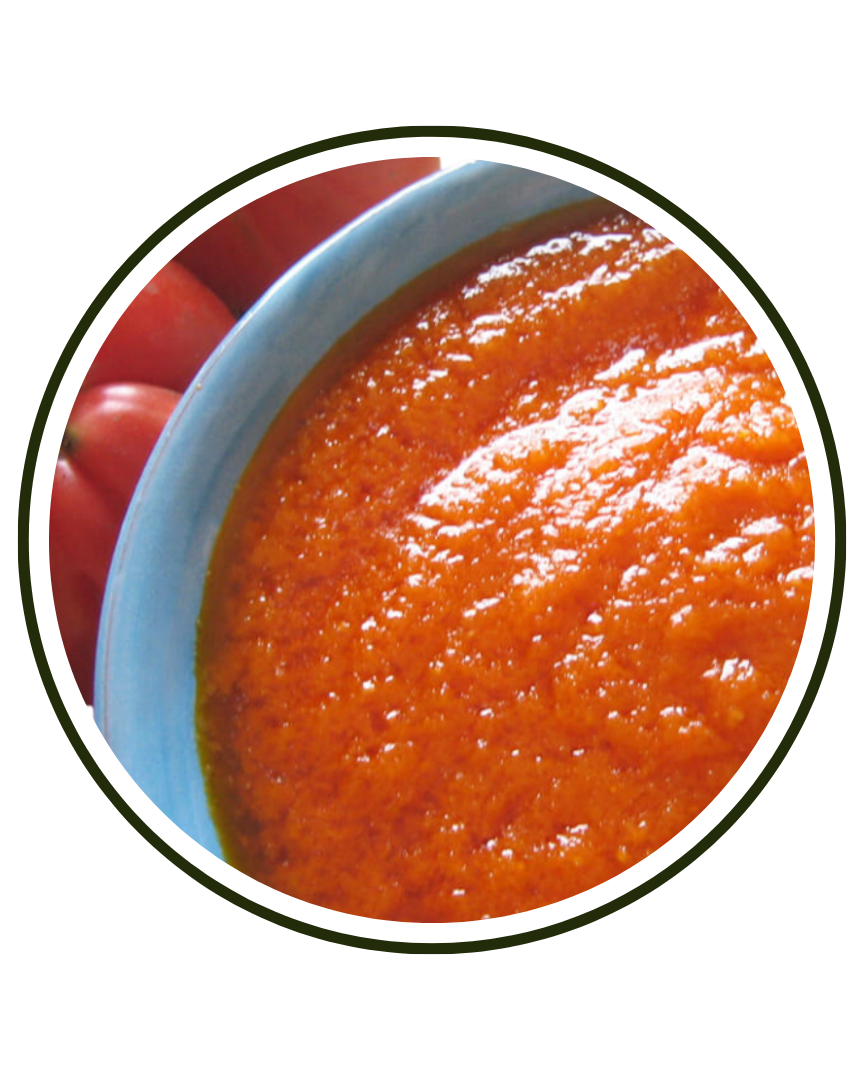
Lactobacillus helveticus
Background
Lactobacillus helveticus is a probiotic strain widely studied for its benefits to digestion, immunity, and stress balance. It is often used in fermented dairy products like cheese and yogurt. For hair health, L. helveticus supports the gut–skin–hair axis by improving nutrient absorption, lowering inflammation, and helping the body manage stress, which can reduce hair loss.
Origin, Source, and Traditional/Historical Use
Originally identified in Switzerland, L. helveticus has been used in cheese-making for centuries. Traditional diets rich in fermented foods containing this probiotic were linked to better digestion and resilience. Modern supplements now provide purified, concentrated forms.
Key Active Compounds and Chemical Composition
L. helveticus produces lactic acid, bioactive peptides, and short-chain fatty acids (SCFAs). These support gut barrier strength, regulate immune activity, and reduce stress hormones, creating a healthier environment for hair follicles.
Bioavailability, Absorption, and Metabolism
After ingestion, L. helveticus survives stomach acid and colonizes the intestines temporarily. It interacts with gut cells and microbiota, releasing peptides that circulate throughout the body. Its effects last as long as supplementation continues.
Current Availability and Use
L. helveticus is widely available in probiotic capsules, powders, and fermented dairy products. It is often combined with other probiotic strains to maximize benefits for digestion, immunity, and stress reduction.
Clinical Features
- Stress reduction: Studies show lowered cortisol and improved mood balance after 4–8 weeks of use.
- Sleep and relaxation: Combined with other probiotics, improved sleep quality and reduced nighttime waking.
- Digestive health: Reduces bloating, improves lactose digestion, and supports nutrient absorption.
- Immune regulation: Strengthens immune defenses and lowers inflammation, supporting scalp and follicle health.
- Skin and hair link: By lowering inflammation and stress, it indirectly reduces shedding and supports hair thickness.
Dosing
Typical daily dose: 1–10 billion CFU (colony-forming units). Available in capsules, probiotic blends, and dairy-based supplements.
Safety
Generally safe for adults and children. Mild side effects may include temporary gas or bloating. Safe for pregnant and breastfeeding women. Caution is advised in severely immunocompromised individuals.
Mechanism of Action
- Gut–hair axis: Enhances absorption of nutrients like zinc, biotin, and iron needed for hair growth.
- Cortisol regulation: Lowers stress hormone levels linked to hair shedding.
- Immune balance: Increases regulatory T cells and reduces inflammatory cytokines (IL-6, TNF-α).
- SCFA production: Butyrate and acetate improve gut and systemic anti-inflammatory activity.
- Peptide release: Produces bioactive peptides that positively affect brain and stress pathways.
- Ouwehand AC, et al. Clin Nutr. 2002;21(2):125-131. doi:10.1054/clnu.2001.0513. PMID:11884015.
- Messaoudi M, et al. Br J Nutr. 2011;105(5):755-764. doi:10.1017/S0007114510004319. PMID:20974015.
- Savilahti E, et al. Nutrients. 2021;13(6):1877. doi:10.3390/nu13061877. PMID:34065924.
- Nishida K, et al. Benef Microbes. 2017;8(4):485-494. doi:10.3920/BM2016.0185. PMID:28617302.
- Ait-Belgnaoui A, et al. Neurogastroenterol Motil. 2014;26(5):646-656. doi:10.1111/nmo.12329. PMID:24612321.
- LeBlanc JG, et al. Nutrients. 2011;3(1):34-53. doi:10.3390/nu3010034. PMID:22254036.
- Marco ML, et al. J Dairy Sci. 2017;100(12):9952-9970. doi:10.3168/jds.2017-12939. PMID:29153160.
- Takada M, et al. Nutrients. 2016;8(3):122. doi:10.3390/nu8030122. PMID:26999199.
- Dinan TG, et al. Biol Psychiatry. 2013;74(10):720-726. doi:10.1016/j.biopsych.2013.05.001. PMID:23759244.
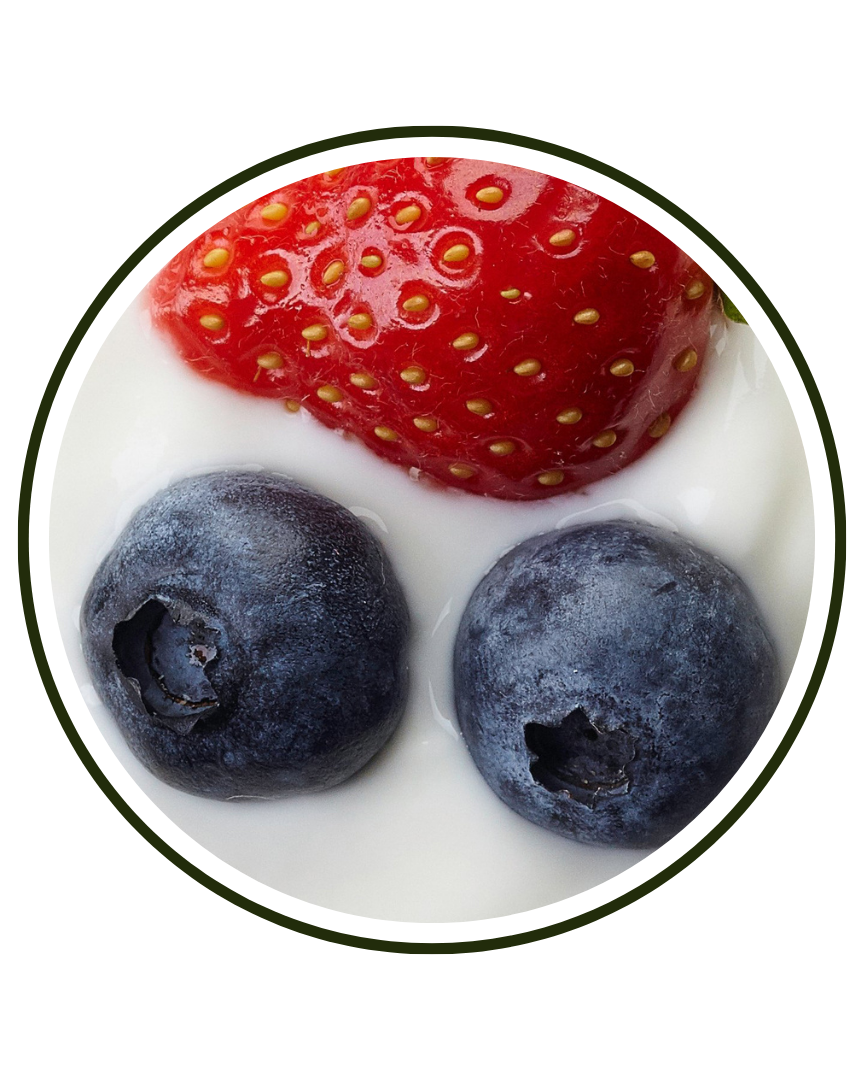
Lactobacillus brevis
Background
Lactobacillus brevis is a probiotic, or “friendly” bacteria, that lives in the human gut, mouth, and fermented foods. It is known for producing gamma-aminobutyric acid (GABA), a calming brain chemical that helps reduce stress and improve sleep. For hair, L. brevis supports the gut–brain–hair axis by reducing inflammation, improving nutrient absorption, and lowering stress hormones that can trigger shedding.
Origin, Source, and Traditional/Historical Use
L. brevis is naturally found in sauerkraut, pickles, kimchi, kefir, and yogurt. While not identified as a separate probiotic until the 20th century, cultures consuming fermented foods rich in this bacteria were noted for better digestion and overall vitality.
Key Active Compounds and Chemical Composition
L. brevis produces lactic acid, short-chain fatty acids (SCFAs), and high levels of GABA. It also generates antimicrobial peptides that protect the gut and regulate the immune system.
Bioavailability, Absorption, and Metabolism
When taken orally, L. brevis survives stomach acid and temporarily colonizes the intestines. It interacts with gut cells and microbiota, producing metabolites like SCFAs and GABA that circulate in the body. Its activity lasts while supplementation continues.
Current Availability and Use
L. brevis is available in probiotic supplements, often in multi-strain blends. It is also naturally present in many fermented foods. It is widely used in gut health and stress-support formulas.
Clinical Features
- Stress and cortisol reduction: Animal and human studies show lowered stress hormones and calmer behavior after 4–6 weeks.
- Sleep quality: By producing GABA, it helps improve relaxation and sleep patterns.
- Digestive health: Improves gut barrier function and reduces bloating.
- Immune regulation: Reduces inflammatory markers, supporting scalp and follicle health.
- Hair growth link: In mice, supplementation improved hair density and reduced stress-related shedding.
Dosing
Typical daily dose: 1–10 billion CFU (colony-forming units). Available in capsules, powders, and probiotic blends.
Safety
L. brevis is generally safe. Mild side effects may include temporary gas or bloating. Safe for adults, children, and during pregnancy under medical supervision. Caution in immunocompromised individuals.
Mechanism of Action
- GABA production: Raises calming neurotransmitter levels, reducing stress-related hair loss.
- Gut–hair axis: Enhances absorption of biotin, zinc, and amino acids vital for hair.
- Immune modulation: Lowers inflammatory cytokines (IL-1β, TNF-α) affecting follicles.
- SCFA activity: Produces butyrate, which supports anti-inflammatory pathways.
- Antimicrobial effect: Inhibits harmful gut bacteria, restoring microbiome balance.
- Barrett E, et al. Appl Environ Microbiol. 2012;78(3):928-934. doi:10.1128/AEM.06344-11. PMID:22101046.
- Komatsuzaki N, et al. Food Microbiol. 2005;22(6):497-504. doi:10.1016/j.fm.2005.01.002.
- Mazzoli R, et al. Front Microbiol. 2016;7:1403. doi:10.3389/fmicb.2016.01403. PMID:27708618.
- Kwon O, et al. J Microbiol Biotechnol. 2002;12:593–598.
- Ooi LG, et al. Int J Mol Sci. 2010;11(6):2499-2522. doi:10.3390/ijms11062499. PMID:20640165.
- Nishida K, et al. Front Psychiatry. 2019;10:100. doi:10.3389/fpsyt.2019.00100. PMID:30949006.
- LeBlanc JG, et al. Nutrients. 2017;9(5):484. doi:10.3390/nu9050484. PMID:28475161.
- Savilahti E, et al. Nutrients. 2021;13(6):1877. doi:10.3390/nu13061877. PMID:340
- Dinan TG, et al. Biol Psychiatry. 2013;74(10):720-726. doi:10.1016/j.biopsych.2013.05.001. PMID:23759244.

